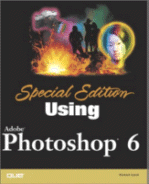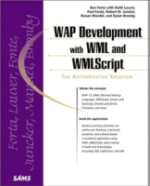Computer Book Reviews
Page Two of TwoSpecial Edition Using Adobe Photoshop 6 by Richard Lynch
Que, December 2000.Trade Paperback, 964 pages.
ISBN: 0789724251
Ordering information:
Amazon.com.
 This comprehensive reference for
Photoshop 6 covers numerous uses
of the software, as well as explanations
of graphics and the Photoshop interface.
The book begins with coverage of
new features in the Photoshop 6 version,
including Layer Styles, Bezler tools and
on-canvas text editing. Other sections
cover Photoshop skills, including
creating images, masking, using freehand
tools, image processing, image resolution,
scanning images, color handling, repairing
and altering images, using filters, enhancing
images, special effects, web graphics,
image printing, image protection and image
storage. The reference also includes
information about using Photoshop with
your computer and a web resources library.
The reference is also very useful for
learning how colors and graphics are
handled for both printing and the Web.
The book provides methods and instruction
for achieving the best results, whether you
are sending something to the printer or
creating a Gif animation for your website.
Photoshop 6 is such a powerful tool that
a solid reference guide like Special Edition
is a necessity so users are sure to get the
most they can out of the impressive software
package.
This comprehensive reference for
Photoshop 6 covers numerous uses
of the software, as well as explanations
of graphics and the Photoshop interface.
The book begins with coverage of
new features in the Photoshop 6 version,
including Layer Styles, Bezler tools and
on-canvas text editing. Other sections
cover Photoshop skills, including
creating images, masking, using freehand
tools, image processing, image resolution,
scanning images, color handling, repairing
and altering images, using filters, enhancing
images, special effects, web graphics,
image printing, image protection and image
storage. The reference also includes
information about using Photoshop with
your computer and a web resources library.
The reference is also very useful for
learning how colors and graphics are
handled for both printing and the Web.
The book provides methods and instruction
for achieving the best results, whether you
are sending something to the printer or
creating a Gif animation for your website.
Photoshop 6 is such a powerful tool that
a solid reference guide like Special Edition
is a necessity so users are sure to get the
most they can out of the impressive software
package.
WAP Development with WML and WMLScript by Ben Forta, et al.
Sams, November 2000.Trade Paperback, 586 pages.
ISBN: 0672319462
Ordering information:
Amazon.com.
 WAP (Wireless Application Protocol)
is a language designed to allow
programmers to develop content for
wireless devices, including wireless phones
and handhelds. This guide helps programmers
develop WAP pages (pages that can be viewed
with wireless devices) and scripts using
WML and WMScript. WAP pages are
similar to HTML and XML, but unlike
large webpages, each different screen
on the phone or wireless device is called a card.
Another difference is that with WAP pages
there is no set screen size. There are only
a couple screen sizes to worry about when
programming for the Internet, but with
wireless devices there are numerous sizes and screen
styles to consider. The concept of cards (WAP pages)
and decks of cards (sets of cards in a single
file) gives programmers a method for dealing with the
uncertainty of the screen size and a way
to set up user navigation. Other WAP
concepts introduced in the book include
using images, working with input, email integration,
timers, notifications and security. The reference
includes sample applications for a currency converter,
user directory, scheduling and ecommerce. An appendix
in the book includes a WML and WMLScript
reference library and the accompanying CD-Rom
contains device emulators (WAP browsers) and
third party editors and tools.
WAP (Wireless Application Protocol)
is a language designed to allow
programmers to develop content for
wireless devices, including wireless phones
and handhelds. This guide helps programmers
develop WAP pages (pages that can be viewed
with wireless devices) and scripts using
WML and WMScript. WAP pages are
similar to HTML and XML, but unlike
large webpages, each different screen
on the phone or wireless device is called a card.
Another difference is that with WAP pages
there is no set screen size. There are only
a couple screen sizes to worry about when
programming for the Internet, but with
wireless devices there are numerous sizes and screen
styles to consider. The concept of cards (WAP pages)
and decks of cards (sets of cards in a single
file) gives programmers a method for dealing with the
uncertainty of the screen size and a way
to set up user navigation. Other WAP
concepts introduced in the book include
using images, working with input, email integration,
timers, notifications and security. The reference
includes sample applications for a currency converter,
user directory, scheduling and ecommerce. An appendix
in the book includes a WML and WMLScript
reference library and the accompanying CD-Rom
contains device emulators (WAP browsers) and
third party editors and tools.
Developers that are familiar with both HTML and XML will have an advantage, because WML is based on those languages. Author Ben Forta is excellent at explaining programming languages through clear instruction and sample code. Some of Forta's previous books include The Coldfusion 4.0 Web Application Construction Kit, Sams Teach Yourself SQL in 10 Minutes, Sams Teach Yourself HomeSite 4 in 24 Hours and Sams Teach Yourself ColdFusion Express in 24 Hours. Web developers ready to provide content for wireless devices will be publishing in no time with this handy reference.
Computer Book Reviews
Page One | Page Two
Return to Book Reviews Index
More from Writers Write
